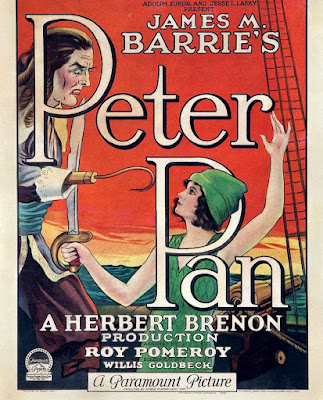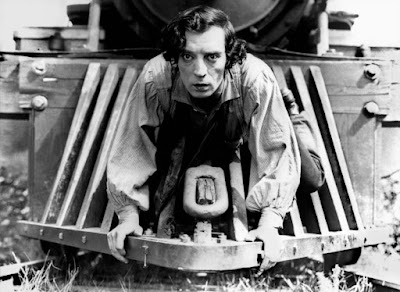People are often surprised to find that silent film versions exist of many popular classic films.
Earlier this month I accompanied the silent version of 'The Ten Commandments' (1923). And in June, I'll accompany the silent film version of '20,000 Leagues Under the Sea.'
Perhaps one of the best silent film versions of a popular story is 'Peter Pan' (1924), which Paramount Pictures produced with involvement of J.M. Barrie, author of the original stage play.
Yes, it's the same classic story we all know from numerous remakes by Walt Disney and others. It has it all: Captain Hook, Tinkerbell, and pirates and mermaids and crocodiles, too.
You'll get to see this original adaptation on the big screen, with live music by me, on Wednesday, May 31 at the Rex Theatre in downtown Manchester, N.H. Showtime is 7 p.m. More info is in the press release pasted below.
On a personal note, the silent 'Peter Pan' holds the distinction of being the film that sparked my own return to working with the genre after many years away from it.
As a teenager, I was a fanatical silent film fan, perusing the monthly Blackhawk Films catalog and saving up to buy 8mm prints of great silent-era comedies, which I still have.
But in college, my interests drifted elsewhere, and for a couple of decades I didn't pay much attention to silent cinema or the era that produced it.
Then, on a whim, I attended the Kansas Silent Film Festival in March of 2000. And there, the first movie on the Saturday morning program was Buster Keaton's 'The Cameraman,' with live music by Rodney Sauer and the Mont Alto Motion Picture Orchestra.
I was familiar with the Keaton film, but seeing it with an audience and with live music was a revelation. It was also a great warm-up for the afternoon's featured attraction (you guessed it): the original silent 'Peter Pan,' also with music by Mont Alto, and which I'd never seen before.
I realized: this was what life feels like to me.
And so began a long (but not too long) journey that led to actively accompanying 120 silent film screenings each year now, giving other people a chance to experience what I felt back almost a quarter-century ago in Topeka, Kansas.
That screening, by the way, included a projection mishap still talked about in Kansas. They were using a 16mm print and about 20 minutes in, a reel change produced a flopped image, with everything reversed: what was on the left was on the right, and vice versa.
This wasn't immediately apparent until the first intertitle appeared. Suddenly, with the English text reversed, it looked like the Czech language on the screen. Oops!
What had happened, of course, was that the reel had been rewound incorrectly after a prior showing. And with no soundtrack on the print, no one could tell it was being fed into the projector upside down until the first garbled title flashed onto the screen.
The film was quickly rewound and restarted, this time oriented correctly. Somehow, this added to the magic of the occasion to me.
And it's this magic that I try to keep in mind when doing music for 'Peter Pan,' which continues to be popular with audiences and is one of titles I most frequently accompany.
I do try to think back and remember the effect the film had on me when I first saw it, which was long enough ago now to encompass practically the entire history of silent cinema. I've since accompanied it several dozen times, at least.
None of that matters to anyone attending the May 31 screening in Manchester. So I have to remember: keep it light. Let the film do its thing. Play music that helps people discover the movie the way you did.
Hope you'll be able to join us on Wednesday, May 31 at the Rex Theatre. If nothing else, your help is needed in the audience participation sequence!
* * *
MONDAY, MAY 22, 2023 / FOR IMMEDIATE RELEASE
For more info, contact: Jeff Rapsis • (603) 236-9237 • jeffrapsis@gmail.com
Rarely seen silent film version of 'Peter Pan' at Rex Theatre on Wednesday, May 31
Original big-screen adaptation of magical fantasy classic, a major 1924 hit, to be shown with live musical score
MANCHESTER,
N.H.—It was the film that introduced movie-goers to visions of flying
children, magical fairies, human-like animals and menacing pirates.
It
was the original silent film adaptation of 'Peter Pan,' a picture
personally supervised by author J.M. Barrie. The film was a major hit
when released in 1924, with audiences eager to get their first
big-screen look at the wonders of Neverland.
Movie fans can see
for themselves when the first 'Peter Pan' (1924) is screened on
Wednesday, May 31 at 7 p.m. at the Rex Theatre, 23 Amherst St.,
Manchester, N.H.
The program will feature live music for the
movie by silent film accompanist Jeff Rapsis. General admission tickets
are $10 per person and available online at www.palacetheatre.org at the door.
Thought
lost for many years, and overshadowed by more recent adaptations, the
original silent 'Peter Pan' maintains its freshness and charm nearly a
century after its original release.
In the story, first presented
as a stage play in 1904, three children in London are visited one night
by Peter Pan, a youth in search of his shadow. Pan shows his new
friends how to fly, and then convinces them to join him in a journey to
Neverland.
There they encounter Indians, mermaids, and a band of
pirates whose leader, Captain Hook, is Pan's sworn enemy. The children
are captured by Hook and taken prisoner aboard his pirate ship, setting
the stage for an epic battle, the outcome of which will determine if the
children may ever return home.
Though the Peter Pan story is
well-known today due to subsequent adaptations (and also merchandising
that includes a ubiquitous brand of peanut butter), the tale was
virtually new when Hollywood first brought it to film in the early
1920s.
In England, author Barrie gave his blessing to the
first-ever screen adaptation, though he retained control over casting
and insisted that any written titles in the film be taken directly from
his own text.
The film's highlights include special effects that maintain their ability to dazzle even today. The film's memorable images include a group of mermaids entering the sea, a miniature Tinkerbell interacting with full-sized children and adults, and a pirate ship lifting out of the water and taking flight.
'Peter Pan' also includes a cast of animal characters played by humans in costume, including the family dog Nana and an alligator who serves as Hook's nemesis, lending the film a magical quality.
After the film's release, no copies of the original 'Peter Pan' were known to exist, and for many years the film was regarded as lost. However, in the 1950s a single surviving print turned up in the George Eastman Archives in Rochester, N.Y., from which all copies today have descended.
Accompanist Jeff Rapsis specializes in creating live musical scores for films made prior to the introduction of recorded sound. Based in New Hampshire, Rapsis specializes in improvising music for silent film screenings at venues ranging from Harvard University in Cambridge, Mass. to the Niles Essanay Silent Film Museum in San Francisco, Calif.
Rapsis creates film scores in real time, as a movie is running, using a digital synthesizer to reproduce the texture of a full orchestra. He averages about 120 performances per year, and has created music for more than 380 different silent feature films.
"Improvising a movie score is a bit of a high wire act, but it can result in music that fits a film's mood and action better than anything that can be written down in advance," Rapsis said. "It also lends a sense of excitement and adventure to the screening, as no two performances are exactly alike."
'Peter Pan' is the latest in a series of silent films with live music scheduled for this year at the Rex Theatre, a restored venue in downtown Manchester that was reopened in 2019.
The series gives movie-goers a chance to rediscover the experience of silent cinema presented as it was intended: on a big screen, with live music, and with an audience.
"If you can put all the original elements together, the films of early Hollywood still come to life," said Rapsis. "These are the films that caused people to first fall in love with the movies."
‘Peter Pan’ (1924) will be shown on Wednesday, May 31 at 7 p.m. at the Rex Theatre, 23 Amherst St., Manchester, N.H. General admission $10 per person; tickets available online at www.palacetheatre.org or at the door.
Tickets and more information, call (603) 668-5588 or visit www.palacetheatre.org









.jpg)












